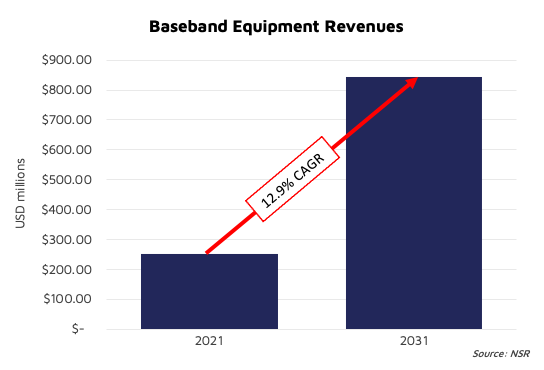Virtualizing Satcom Business Models
Virtualization has been among the top buzzwords among satcom equipment vendors over the last few years, but the truth is that little tangible progress has occurred. Obviously, the technical requirements of virtualizing network functions need time, but most of the vendors are now about to launch their new iteration of VSAT platforms incorporating some sort of virtualization. Consequently, the key questions now are if the market is mature enough to take advantage of virtualization and how vendors will need to adapt their business models.

Ground Segment is more critical than ever for the future of the satellite industry playing an integral role in unlocking new markets and integrating with the mainstream telco ecosystem. This will pose a major R&D burden on equipment vendors, but those who can thrive in this transition will be able to capture spectacular growth. NSR’s Global Satellite Ground Segment, 7th Edition report projects Baseband Equipment Revenues to grow at 12.9% CAGR over the next 10 years generating $6B in 2021-31 cumulative revenues. While exceptional technology is a must, this alone won’t be enough, and vendors will need to find the right business model to stay relevant.
Do Boxes Matter?
Equipment vendors traditionally measured their ‘output’ in baseband chassis and terminal shipments. With virtualization and, at some point, transition to the Cloud, this methodology is losing relevance as the hardware piece will be based on ‘white-box’ infrastructure.
Vendors will need to focus on what differentiates them and adds value to the network operators, or what is the same, the tools to manage those satellite networks. Hence, equipment vendors will need to become ‘network functions vendors’ and stop measuring shipments to migrate towards a capabilities-based model. Generally, this would mean measuring output in Gbps (capacity managed), but different functions might be measured based on different attributes (throughput, encryption, compression, etc.).
Evolving Monetization
Naturally, monetization strategies will need to be based on the new measures of output, abandoning the hardware-centric ‘revenue per shipment’ model. Interestingly, while pure-CAPEX models would still be possible, this opens the door to more risk-sharing models such as pay-per-use.
One could envision new ‘Network function’ capabilities priced based on $/Gbps. With this metric showing some variability depending on additional features (redundancies, network complexity, level of customization, etc.). Today, the portion of CAPEX that goes into Ground Segment (Teleport, Baseband, TT&C) represents about 30% of the total CAPEX on the network (Satellite + Launch + Insurance + Ground Segment). This will likely show little variability in the early days of virtualization, but the advantages of migrating to the Cloud should push the contribution of Ground Segment to the total system CAPEX down.
Is the Ecosystem Ready?
There continues to be certain gaps in the ecosystem for full adoption of virtualization. True virtualization involves synchronization across various equipment pieces (baseband, modulators/demodulators, RF equipment), and while the DIFI consortium is working on common standards, wide implementation could still take several years.
Satellite Operators themselves are still unclear on how to leverage virtualization. Some might prefer private Cloud platforms to keep control over the network, while others would be open to migrate those functions to Hyperscalers (Azure, AWS, etc.) to gain economies of scale. Even Hyperscaler offers in this segment are still vaguely defined (unlike in other Space segments like EO).
At the core of the debate is who takes the responsibility for running and orchestrating all the different elements of the network (satellite, VSAT, link with terrestrial, etc.). And again, some operators seem to prefer to develop those APIs internally, while others prefer to rely on third parties. All in all, these create a lot of uncertainty among vendors as they will need to be able to interact with multiple scenarios (multi-orbit, multi-frequency, different orchestration APIs, MEF, etc.). At this stage, some vendors could decide to remain solution providers, but others might venture to become ‘ground segment operators, keeping in mind that Hyperscalers don’t want to get commoditized and just run applications; they want to sell services as well!.
The Bottom Line
The adoption of virtualization will bring multiple changes to satcom business models. Particularly, equipment vendors will need to migrate to solutions-based outputs and monetization strategies ($/Gbps).
While virtualization will materialize relatively soon (3-5 years), there are still multiple elements that need to align to really see the value out of this transition (technologies, standards, infrastructure strategies, or definition of hyperscalers’ role among others).
The satellite industry is a few years behind terrestrial operators in the adoption of virtualization and could learn best practices from their experiences. Analysys Mason has been advising Telecom Operators, CSPs and vendors with their Cloud Infrastructure Strategies.
NSR supports vendors, service providers, satellite operators, end-users, public agencies and financial institutions in their technology and business strategy assessment and planning.
Please contact info@nsr.com for more information.
